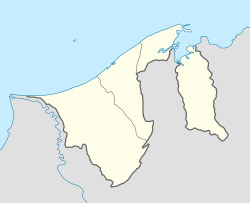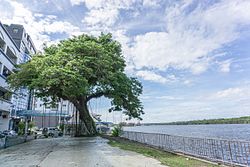Kuala Belait
| Kuala Belait | ||
|---|---|---|
|
|
||
| Coordinates | 4 ° 35 ' N , 114 ° 12' E | |
| Basic data | ||
| Country | Brunei | |
| Belait | ||
| ISO 3166-2 | BN-BE | |
| Mukim | Kuala Belait | |
| Residents | 28,000 (2010) | |
|
Kuala Belait by day
|
||
Kuala Belait ( Jawi script:کوالا بلايت) is a city (Pekan Kuala Belait) and an administrative district ( Mukim ) in the district ( Daerah ) Belait of the Sultanate of Brunei . The urban district has about 28,000 inhabitants (2010).
geography
Mukim and the city are located in the north of the island of Borneo on the coast of the South China Sea in the far west of the sultanate. The Mukim borders the Malaysian state of Sarawak in the southwest . Immediately to the west of the city center, the Belait , the longest river in Brunei, after which the city, Mukim and district are named, flows into the sea. In the swampy surroundings of the black water river Belait south of the city, the vegetation changes into tropical rainforest.
Bandar Seri Begawan , the capital of Brunei, is 120 kilometers northeast, Miri , the city and center of the Malaysian oil industry, is 35 kilometers southwest of Kuala Belait.
Kuala Belait is divided into several kampongs (villages). The main ones are Kampong Pekan Belait , Kampong Melayu Asli (which is where the largest mosque is located), Kampong Melayu Baru , Kampong Cina (the Chinese quarter), Kampong Temenggong, Kampong Lubok Palam and Kampong Sungai Teraban .
Other districts outside the actual city center are Kampong Sungai Teraban west of the Belait River, the new and modern Kampong Pandan in the east, the port area Kampong Sungai Duhon and the more village-like Kampong Rasau in the southwest with the Rasau gas field of Brunei Shell Petroleum .
Administrative division
The Mukim consists of the settlements:
- Pekan Kuala Belait
- Kampong Mumong 'A
- Kampong Mumong 'B
- Kampong Pandan 'A
- Kampong Pandan 'B
- Kampong Pandan 'C
- Kampong Sungai Melilit
- Kampong Sungai Teraban
These settlements each have their own postal code. Further settlements have now been assigned as a unit to the main town of Kampong Pekan Belait:
- Kampong Melayu Asli
- Kampong Melayu Baru
- Kampong China
- Kampong Temenggong
- Kampong Lubok Palam
- Kampong Sungai Duhon
Kampong Mumong 'A' and Kampong Mumong 'B' are collectively known as Mumong and form a suburb of Kuala Belait. Kampong Mumong 'A is also home to the Skim Tanah Kurnia Rakyat Jati Mumong social housing estate . Kampong Mumong 'B is also sometimes referred to as Kampong Mumong Selatan .
Similarly, Kampong Pandan 'A, Kampong Pandan' B and Kampong Pandan 'C form the suburb of Kampong Pandan . Perumahan Negara Pandan is another social housing project with buildings scattered across the three settlements.
Kampong Sungai Melilit has its own postal code but apparently no residents.
History of the city
At the beginning of the 20th century, Kuala Belait ( German: mouth of the Belait ) was a small fishing village with about 400 inhabitants. After 1927, when an oil field was discovered south of neighboring Seria , a place had to be found to bring drilling equipment inland. The choice fell on the place at the Belait estuary, there were no paved roads at that time. The original district capital, Kuala Balai , was considered inaccessible and so an administrative center (1929) and a river port were established in Kuala Belait. The carrier of the development was the British Malayan Petroleum Company (BMPC), the forerunner of today's Brunei Shell Company . In the 1930s, Kuala Belait and the neighboring town of Seria were the most important settlement in the area of today's Sultanate of Brunei. The first government buildings were wooden structures that housed several authorities. In 1931 the first roads were built, telephone connections were laid, the English school (the first in Brunei) and a hospital were built. At that time there were more than 3,000 inhabitants.
Before the Japanese captured Kuala Belait in December 1941, the British set the oil wells on fire and destroyed the production facilities. The Japanese, who used Kuala Belait as their naval headquarters, managed to resume oil production with the help of local workers. Towards the end of World War II, Kuala Belait and Seria suffered severe damage from Allied bombing.
Under the rule of Sultan Omar Ali Saifuddin III. Kuala Belait was rebuilt after the war. Numerous commercial buildings from this period still shape the image of the city today. In December 1958, after the completion of several bridges, Kuala Belait was connected to the Brunei road network. The city continued to grow. In the 1960s and 1970s, additional buildings for authorities (police headquarters) and the public (town hall) as well as several schools were built. After Brunei gained independence on January 1, 1984, construction continued and entire districts were built as planned. With the foreseeable end of oil and gas production, the weight in Kuala Belait is slowly shifting in the direction of tourism, which numerous new hotels have been building since the beginning of the 21st century.
economy
Immediately south of the city is the Rasau gas field, which was discovered in 1979 and has been exploited since 1983. The most important branch of business is still oil and gas production and the related industries and services, followed by credit and trading companies and the emerging tourism sector.
tourism
- Silver Jubilee Park with a memorial arch, monuments, exhibitions and a children's playground, near the beach on the 25th Jubilee of Sultan 1992 Hassanal Bolkiah built
- Istana Mangella , the Sultan's palace
- St. John's Church with one of the three parishes of the Apostolic Vicariate of Brunei
Infrastructure
The Kuala Belait Highway ( Malay Lebuhraya Kuala Belait ; Jawi: ليبوهراي کوالا بلايت) bypasses the city to the south and is part of the Pan Borneo Highway (Malay Lebuhraya Pan Borneo ), a trunk road that will finally extend the north of the island of Borneo from Kuching via Kota Kinabalu will be continuously developed. The border crossing to Malaysia ( Kampong Rentis ) is twelve kilometers west of downtown Kuala Belait .
Other geographic objects
- Sungai Tujoh - Customs post on the border with Sarawak , Malaysia
- Estuary of the Belait River , the longest river in Brunei
- Istana Mangellela , residence of Sultan Hassanal Bolkiah in Kuala Belait
Individual evidence
- ↑ Population statistics on World Gazetteer. Accessed April 20, 2013 (German).
- ↑ a b Brunei Postal Services - postcodes ( en-GB )
- ↑ Geoportal - Survey Department ( en-US )
- ^ "Kuala Belait, the oil district capital", article in the Brunei Times of November 18, 2007. (No longer available online.) Archived from the original on March 25, 2013 ; accessed on April 19, 2013 (English). Info: The archive link was inserted automatically and has not yet been checked. Please check the original and archive link according to the instructions and then remove this notice.


